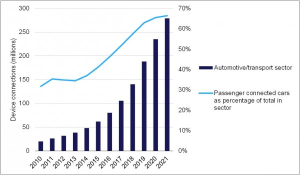Everyone loves super heroes and secret agents with amusing gadgets from Hollywood movies. And the first gadget that fascinates us the most is their automobiles. From bat mobile to super modified Aston Martin driven by 007. It feels so much fascinating watching how these vehicles run driverless, find their bosses just at the time they need, routing the shortest and fastest path and locating a place to hide. These fantasies are now the future of the automobiles industries which currently, are in their development phase.
Five years ago mobile phones were at the forefront of technology. By 2010, the focus was on tablet computers but now billions of yen, dollars and pounds are being invested in what is seen as the next digital playground – car.
The passenger automobile is one of the venues where there is tremendous opportunity for adding connectivity. According to Analysis Mason’s M2M worldwide forecast 2013, there will be 279 million connected road vehicles worldwide by 2021. Of those vehicles, 66% or 185 million will be passenger connected cars. Approximately 54% of passenger connected cars by 2021 will be in developed markets like Europe, North America and the developed countries of Asia. This obviously leaves a stupendous opportunity in emerging markets like China, India, Brazil, the Middle East and other emerging countries.

Source: Analysys Mason’s M2M worldwide forecast
Christopher Urmson, the engineer who heads up Google’s self-driving cars research, says “Our plans are to make driving better, so people can do what they want to do, such that their feet are nowhere on the pedals, their minds are everywhere but on the roads”. He is definitely talking about the future cars…..!!!!
What phenomenal things connected cars can do….????
The biggest achievement in this concept is driverless cars which is expected to be on the roads in next five years, as said by GOOGLE’s cofounder Sergey Brin. Moreover finding a free parking space, in European cities like Amsterdam can even book a parking space for himself before leaving from home (which I personally don’t think possible in India because either we do not know the law or we don’t care about it) and the car will help in navigating to that place. Connected cars offer real time traffic details that are accessed from the cloud thereby providing alternative routes which can assist in saving fuel, time and money.
A smart connected system will monitor the condition of car and maintenance by notifying the time of repairing and servicing of cars and other services that can be provided from the dealer part.
Insurance companies are enticing safe drivers with several discounts offers depending upon the style of driving which is analyzed by an algorithm by the software installed in the on Board Diagnostics of car. It can also help in checking the false claim by the owner.
But before these cars get a green signals to hit the road and not hitting the other vehicles. These cars have to pass through several applications checks to ensure the safety on the roads.
Some of the key IoT applications that are facilitated by embedded connectivity in cars include the following:
- Safety: European safety initiatives, such as eCall, rely on connectivity to contact emergency services and transmit the location of a vehicle to them, even if its occupants are unable to do so. Various car manufacturers have incorporated eCall within their range of connected services.
- Navigation and information: The addition of connectivity to built-in satellite navigation systems enables drivers to receive real-time traffic information, which would help them to avoid congestion or other delays. Manufacturers typically include this feature as part of a suite of connected car services. Additional information services include concierge calling services. In addition, several car manufacturers have used embedded connectivity to provide services such as tracking and access to roadside assistance or other technical services.
- Vehicle management: The emergence of fully electric vehicles has led to the growth of cloud-based vehicle management services, which enables owners to remotely check the distance their car can travel on the current battery level in order to allay ‘range anxiety’, or switch on their in-car heating a few minutes prior to setting off. Engine diagnostics also fit into this application category whether that information is provided to end-users, dealerships, manufacturers or repair shops.
- Infotainment: Built-in connectivity enables content and information to be streamed directly to the vehicle, giving consumers access to it as part of a more convenient and integrated experience without having to use separate devices, which might be distracting or dangerous.

Source: Analysys Mason’s M2M worldwide forecast
Privacy and security
These levels of services are provided to the consumer at a great cost of their privacy and security. The privacy issue has been a huge cause of debate followed by the birth of IoT. Customer has to share their location to the dealer. Moreover BMW recently patched its Connected Drive system as researchers showed it was possible get wireless access to the car’s air conditioning and door locks. And I’m pretty sure we’re going to see many more examples of such vulnerabilities. It’s now technically feasible to hack the steering, braking, etc., since the security of software in cars remains haphazard and sketchy.
To conquer these checks the car manufacturers have fastened their seat belts, tied hands with IT and software companies and pouring millions of $ in solving this situation.
The driverless cars, smart assisting cars right now may not hit the road very soon but sure they are coming and they are going to change our lives that we can’t even imagine yet.









